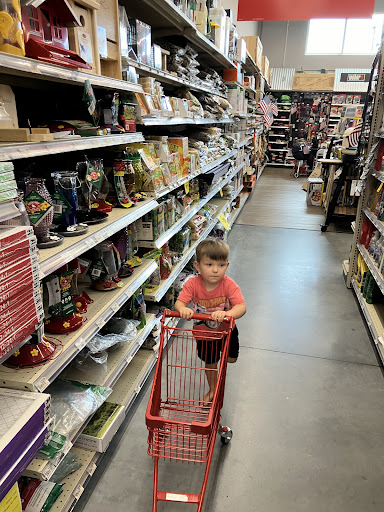Why Having the Right Plumbing Repair Supplies Saves You Time and Money
Plumbing repair supplies are essential for any homeowner to fix common issues like leaky faucets, clogged drains, and running toilets. Handling minor repairs yourself saves you time and can prevent small problems from becoming expensive emergencies.
A basic kit should include tools like wrenches and plungers; materials like plumber’s tape, washers, and O-rings; and sealants like caulk and putty. Having these items on hand provides peace of mind and allows you to solve problems quickly, day or night.
The helpful team at Lowcountry Ace has extensive experience helping Charleston-area homeowners choose the right plumbing repair supplies. We understand the unique plumbing challenges of coastal living and are here to help you stay prepared.
Your Essential DIY Plumbing Toolkit: Tools and Supplies
A solid DIY plumbing toolkit is crucial for handling common issues. You don’t need a professional’s full setup; start with quality basics. Essential tools include adjustable wrenches, pipe wrenches, and tongue-and-groove pliers for most gripping and turning tasks.
No toolkit is complete without both a cup and flange plunger and a drain snake for clogs. For sealing connections, plumber’s tape is a must-have, and an assortment of washers and O-rings will fix most leaky faucets. Epoxy putty is excellent for emergency pipe repairs.
For more guidance, check out The Best Tools for Home Improvement or visit us for quality tools at Ace Hardware Tools James Island.
Essential plumbing repair supplies homeowners should have
Stocking up on a few key plumbing repair supplies can turn a potential disaster into a minor inconvenience.
- Plungers: Have both a flange plunger for toilets and a cup plunger for flat drains like sinks and tubs.
- Assorted washers: These small rubber rings are common failure points in faucets and hoses; a variety pack is a lifesaver.
- Plumber’s tape: Effectively seals pipe threads to prevent leaks at joints.
- Pipe clamps: Stop leaks in an emergency by compressing a rubber gasket around a small hole until a permanent repair can be made.
- Caulking gun and silicone sealant: Create waterproof barriers around sinks, tubs, and showers.
Key tools for basic plumbing repairs
A few specialized tools can expand your DIY capabilities for more complex jobs.
- A basin wrench is designed to reach the hard-to-access nuts that secure faucets to sinks.
- Tubing cutters provide clean, precise cuts on copper and plastic pipes, which helps prevent leaks.
- PEX crimping tools are necessary for making secure connections if your home has PEX piping.
- A hacksaw, a screwdriver set, and a bucket and rags are also essential for various disassembly and cleanup tasks.
The helpful team at Lowcountry Ace can help you choose quality tools that will serve you well for years.
Tackling Common Issues with the Right Plumbing Repair Supplies
Most homeowners will eventually face common issues like leaky faucets, clogged drains, running toilets, or leaky pipes. Being prepared with the right plumbing repair supplies and knowledge can save you time and money. For detailed guides, see resources like How to Repair Leaky Pipes. You can find all necessary items in our Home Improvement Supplies section.
Fixing common faucet and sink problems
A dripping faucet wastes water and money, but the fix is often a simple replacement of worn-out internal parts.
To get the right plumbing repair supplies, you need to identify your faucet type:
- Compression faucets: Leaks usually require new rubber washers or O-rings.
- Cartridge, Ball, and Ceramic Disk faucets: These single-handle faucets often require replacing the entire cartridge or internal seals and springs.
Also, check for clogged faucet aerators if you have low water pressure, and inspect valve seats for corrosion.
Key components of a toilet that might need replacement
A running toilet is usually caused by a faulty part inside the tank.
- The toilet flapper is the most common culprit; if this rubber disc is warped or old, it won’t seal properly.
- A faulty fill valve may not shut off completely, causing the tank to run continuously.
- A failing wax ring at the base of the toilet can cause water to pool on the floor.
- Worn tank-to-bowl bolts or a broken toilet handle can also cause leaks or flushing issues.
For more tips, see our guide on How to Unclog a Toilet.
Best methods and supplies for unclogging drains
You can often clear clogged drains yourself with the right plumbing repair supplies.
- Plunger: Your first line of defense. Ensure a tight seal and plunge vigorously.
- Drain Auger (Snake): Use this to break up or pull out blockages that a plunger can’t reach.
- Drain Cleaners: Use chemical drain cleaners with caution, as they can damage pipes. Enzyme drain cleaners are a safer, eco-friendly option for regular maintenance. For hair clogs, simple plastic hair snakes are very effective.
The best strategy is preventing clogs. Use drain strainers, avoid pouring grease down the drain, and flush drains with hot water regularly.
Understanding Pipes, Fittings, and Valves for Effective Repairs
For larger projects, understanding your home’s pipes, fittings, and valves is key. Knowing what materials you’re working with and how they connect will save you time and prevent leaks. The helpful team at Lowcountry Ace can help you find the right plumbing repair supplies at your local Ace Hardware Hardware Store Near Me.
How to choose the right type of pipe for a repair
Choosing the right pipe depends on its use (water supply vs. drain), location, and local building codes. Always ensure the new pipe is compatible with your existing system.
- PEX: Flexible, freeze-resistant, and easy to install. Used for hot and cold water supply.
- PVC: Rigid white pipe used for drainage and sewer lines. Not for hot water.
- CPVC: Similar to PVC but can handle hot and cold pressurized water.
- Copper: Durable and long-lasting, used for water supply lines. Often requires soldering.
- Galvanized Steel & ABS: Older pipe types you may encounter. Galvanized was used for water supply and can corrode; black ABS pipe is used for drainage.
Common pipe fittings and connectors
Fittings connect pipes and allow the system to turn, branch off, or adapt.
- Couplings: Join two same-sized pipes in a straight line.
- Elbows: Change the direction of a pipe run (e.g., 90 or 45 degrees).
- Tees: Split flow into two directions, forming a “T” shape.
- Adapters & Bushings: Connect pipes of different types or sizes.
- Push-to-connect fittings: Allow for quick, tool-free connections on various pipe types.
- Compression fittings: Use a nut and ring to create a seal, often for connecting fixtures.
Differences between various types of valves
Valves control the flow of water in your plumbing system.
- Gate and Ball Valves: Primarily on/off valves. Ball valves are generally more durable and are common for main shut-offs.
- Globe Valve: Used to regulate the amount of water flow, not just turn it on or off.
- Check Valve: Allows water to flow in only one direction to prevent backflow.
- Shut-off Valves: A general term for any valve that stops water flow to a fixture or an entire house.
- Pressure-Reducing Valve (PRV): Lowers high water pressure from the main line to a safe level for your home’s plumbing.
Advanced Maintenance: Water Heaters, Winterization, and Sealants
Proactive maintenance, including water heater care, winterization, and using the right sealants, is the secret to a healthy plumbing system. A little attention now prevents major headaches later. The helpful team at Lowcountry Ace can help Charleston-area homeowners develop a smart maintenance plan. Visit us at Ace Hardware James Island.
Water heater types and required maintenance
Regular maintenance extends your water heater’s life and improves efficiency.
- Tank water heaters: Annually flush the tank to remove sediment, check the corrosion-fighting anode rod every 3-5 years, and test the temperature and pressure (T&P) relief valve.
- Tankless water heaters: Require annual flushing to prevent mineral buildup, which is critical for their efficiency. Also, clean their inlet filters periodically.
Best practices for winterizing your plumbing
Even a brief Lowcountry freeze can burst unprotected pipes.
- Insulate pipes in unheated areas like crawl spaces and attics with foam insulation.
- Use faucet covers to protect outdoor spigots.
- Drain outdoor lines by disconnecting hoses and opening spigots after turning off their dedicated shut-off valves, if available.
- Test your sump pump before heavy rains to ensure it’s working correctly.
Benefits of specific plumbing chemicals and sealants
Using the right sealant or chemical is crucial for a lasting repair.
- Plumber’s putty: A soft, pliable sealant for faucet bases and drains.
- Teflon tape (PTFE tape): Wraps around threaded connections to create a watertight seal.
- Pipe joint compound (pipe dope): A paste applied to threads, sometimes used with Teflon tape.
- PVC primer and cement: Chemically welds plastic pipes and fittings for a permanent bond.
- Silicone caulk: Provides a flexible, waterproof, and mold-resistant seal for tubs and sinks.
- Enzyme-based drain cleaners: A gentle option for regular maintenance.
- Root killers: Can eliminate tree roots from sewer lines without harming trees.
Frequently Asked Questions about Plumbing Repairs
Even with the right plumbing repair supplies, it’s important to know the limits of a DIY project. Here are answers to some common questions.
Knowing When a Project Requires Advanced Skills
While many repairs are DIY-friendly, some issues signal a more complex problem that may require specialized tools and expertise.
- Major leaks: If a pipe bursts, your first step is to shut off the main water supply to prevent extensive water damage. These repairs often involve complex pipe replacement and knowledge of local codes.
- Sewer line issues: Multiple clogged drains, sewage backups, or foul odors can indicate a main line problem that requires specialized diagnostic equipment.
- Water heater installation: Installing a new water heater, especially a gas or tankless model, involves working with gas lines, high-voltage electricity, and complex venting that must adhere to strict safety codes.
- Low water pressure throughout the house: This could signal a deeper problem with your main water line or a faulty pressure-reducing valve that requires system-level diagnostics.
- When you’re unsure or uncomfortable: Always assess a repair’s complexity before you begin. Attempting a project beyond your skill level can worsen the problem.
How can I find a leak in my home?
Finding hidden leaks early can save you from costly damage.
- Check your water meter: Turn off all water, note the meter reading, and check it again in 30 minutes. If it has changed, you have a leak.
- Listen for running water: In a quiet house, listen for trickling sounds near toilets or behind walls.
- Look for water stains: Discoloration or peeling paint on walls, ceilings, or floors are classic signs of a hidden leak.
- Use food coloring in the toilet tank: Add a few drops to the tank. If color appears in the bowl without flushing, your flapper is leaking.
What’s the difference between a P-trap and an S-trap?
The curved pipe under your sink is a trap, designed to block sewer gases.
A P-trap is the modern, required standard. Its “P” shape holds a water seal that effectively blocks sewer gases from entering your home and catches debris.
An S-trap is an older design prone to siphoning, where the water seal is pulled out, allowing sewer gases to escape. Modern plumbing codes prohibit new S-trap installations due to this issue. If you have an S-trap, consider replacing it with a P-trap.
Your Go-To Source for Plumbing Supplies and Advice
Having the right knowledge and plumbing repair supplies makes all the difference in maintaining your home’s plumbing. Being prepared saves time, money, and stress. Building your toolkit over time is an empowering way to ensure you’re ready for common household plumbing emergencies.
Plumbing can be overwhelming, but the helpful team at Lowcountry Ace is here for our neighbors in Charleston, James Island, and Folly Beach. We offer a wide range of plumbing repair supplies and friendly, knowledgeable advice to keep your home running smoothly.
For all your project needs, find the best home improvement supplies and expert advice at your local Lowcountry Ace. Check out our Find Ace Hardware Your James Island Shopping Guide to learn more about how we can help.
Lowcountry Ace Hardware: Your one-stop shop for home improvement. We offer quality products from trusted brands and expert advice from our experienced staff. Located on James Island, visit us for tools, hardware, fishing gear, power tools, building materials, grills & smokers, electrical and plumbing supplies, and more.

















